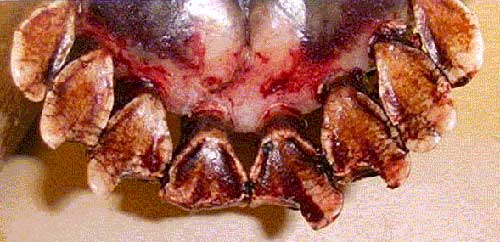 by Ned Rozell October 23, 2003
Julie Maier is a wildlife biologist who keeps a few boxes of moose jaws in her Fairbanks office. Hunters removed the lower jaws from moose they harvested in different areas of Alaska and sent them to the Alaska Department of Fish and Game to help managers determine the age and health of the animals. In the 1980s, biologists noticed cracked and pitted teeth on many samples from the Seward Peninsula. Recently Maier, a research associate with the University of Alaska's Institute of Arctic Biology, decided to take a closer look. 
The Department of Fish and Game started collecting lower jawbones of Seward Peninsula moose in the early 1970s to find the age of moose killed by hunters. The incisors, sharp teeth with which moose snip willow twigs, were often cracked, broken, and pitted. Moose with bad teeth probably have a hard time surviving, especially in winter; a study of Interior moose showed that a cow moose weighing 1,000 pounds eats about 10 pounds of frozen woody twigs each winter day. Maier compared 57 jawbones of Seward Peninsula moose to teeth from moose in Tanana Flats south of Fairbanks and Kalgin Island in Cook Inlet. She found excessive wear and breakage on the Seward Peninsula teeth that she didn't find on teeth from other regions. Moose that are starving will sometimes damage their teeth by gnawing on thick branches, but the broken teeth along with pitted enamel and occasional lesions on the jaws of Seward Peninsula moose suggested another cause. Maier searched for examples of similar damage to moose teeth and found a few cases in Europe and Nova Scotia; all of those moose lived near industrial plants. Could pollution or some other environmental factor on the Seward Peninsula be causing moose to develop bad teeth? The mystery may be similar to the case of black-capped chickadees with deformed bills in Southcentral Alaska that people began noticing in the 1990s. Researchers think the birds, which have long, curved bills that make eating difficult, may be developing the defect as a result of some contaminant in the environment. Using a scoring system in which higher numbers relate to greater tooth damage, Maier is comparing the bad moose teeth of the Seward Peninsula to areas where hunters harvested the moose. She wants to find any connections between moose with bad teeth to how close the animals lived to villages or towns, mines, or certain types of soil. She is also writing a proposal that might fund a study of the genetics of moose in northwest Alaska, to see if bad teeth are an enduring trait of the first moose that colonized the Seward Peninsula.
Source of Story & image:
|